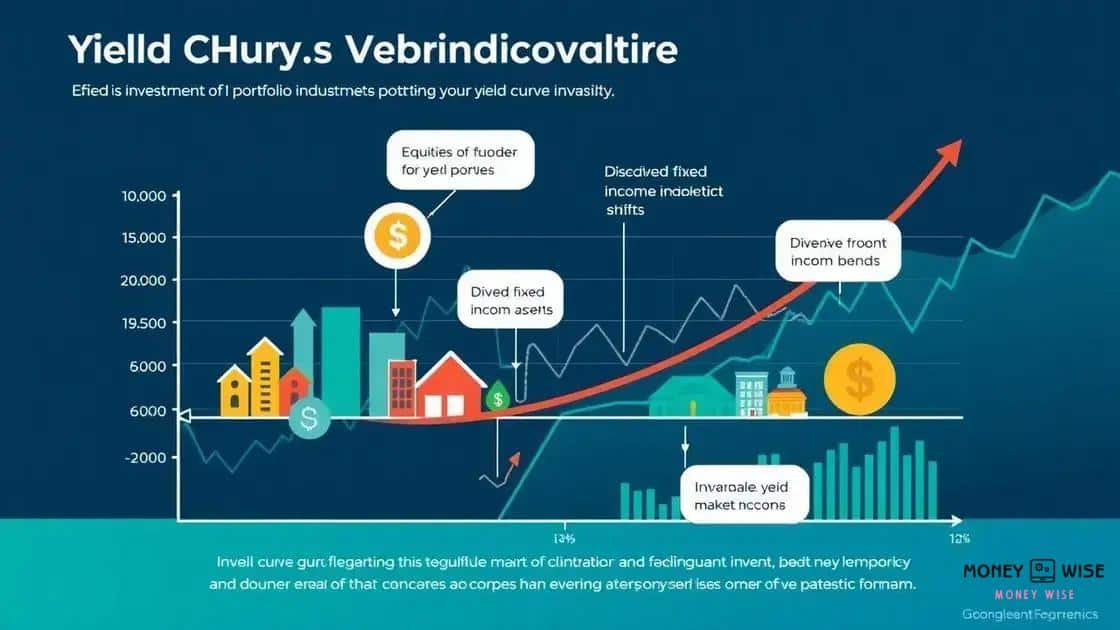Treasury yield curve inversion: what it means for you

A treasury yield curve inversion occurs when long-term interest rates fall below short-term rates, often signaling a potential economic slowdown and impacting investment strategies significantly.
The treasury yield curve inversion has been a hot topic in financial news lately. But what does it truly mean for investors like you? Let’s dive into its significance and the potential implications for your financial strategies.
Understanding the treasury yield curve
Understanding the treasury yield curve is essential for grasping how the economy functions. It serves as a tool to predict future interest rates and overall economic activity.
What is the treasury yield curve?
The treasury yield curve is a graph that shows the relationship between the interest rates of U.S. Treasury securities and their maturities. Essentially, it displays how much interest investors earn on their loans to the government over different time periods. Typically, longer maturities have higher interest rates, reflecting the risks of holding a bond for more extended periods.
Why does it matter?
The shape of the yield curve provides insight into market expectations. A normal upward-sloping curve indicates that investors expect the economy to grow. Conversely, a flat or inverted yield curve may suggest impending economic slowdowns. It is crucial to watch these trends as they can inform your investment decisions.
- The yield curve affects mortgage rates and auto loans.
- It can signal trends in inflation and economic growth.
- Investors often use it to strategize their portfolios.
As changes occur in the economy, the treasury yield curve can shift significantly. Investors often analyze these shifts to gauge potential changes in interest rates and economic activity. For example, when the curve inverts, it has historically preceded recessions. Thus, staying updated on the yield curve can help you make informed financial decisions.
Causes of yield curve inversion

Understanding the causes of yield curve inversion helps in predicting economic trends. This phenomenon occurs when long-term interest rates fall below short-term rates, signaling potential economic problems.
Monetary Policy Actions
One major cause of yield curve inversion is the actions of central banks, such as the Federal Reserve. When the central bank raises short-term interest rates to control inflation, it can lead to an inverted curve. Investors may expect that these high rates will slow economic growth, causing long-term rates to drop.
Investor Sentiment
Investor sentiment plays a significant role in yield curve behavior. During periods of uncertainty, investors may flock to long-term government bonds, driving up their prices while pushing yields down. This demand reflects a lack of confidence in the economy, which can contribute to inversion.
- Economic downturns increase bond purchases.
- Inflation expectations can influence investor behavior.
- Geopolitical issues often create market uncertainty.
Market speculation also contributes to yield curve changes. Investors might predict future economic challenges based on current data and news events. As their expectations shift, so do the yields on different maturities. Understanding these factors is vital for navigating investment strategies amid these changes.
Implications for the economy
The implications of yield curve inversion are significant for the economy. This phenomenon often indicates a slowdown or even a recession. Understanding these effects helps investors and policymakers respond effectively.
Shrinking Economic Growth
When the yield curve inverts, it typically suggests that economic growth may be slowing down. Investors may expect lower consumer spending and business investment because high short-term rates can increase borrowing costs. As companies face higher costs, they may cut back on expansion plans, further affecting job growth.
Impact on Employment
As businesses adjust to decreased demand, layoffs may become more common. An inverted yield curve can lead to uncertainty in the job market. This can cause consumers to tighten their spending, creating a cycle that can lead to a more serious economic downturn.
- Higher unemployment rates may emerge.
- Consumer confidence tends to decline.
- Job creation slows as businesses forecast lower revenues.
Additionally, the inversion can impact various sectors differently. For instance, the housing market may see a slowdown as mortgage rates rise. This can affect home sales and construction jobs. Furthermore, banks may become more cautious in lending, reducing access to credit for individuals and businesses alike. In conclusion, understanding these implications allows individuals and businesses to prepare for potential economic challenges ahead.
How it affects your investments

The inversion of the yield curve can significantly affect your investments. Understanding these impacts is essential for making smart financial decisions. When the yield curve inverts, it often signals a potential recession.
Changes in Bond Investments
As yields on long-term bonds drop, investors may seek better returns in short-term bonds. However, the risk grows if the economy slows down. If you’re holding long-term bonds, be prepared for fluctuations in their value due to changing interest rates.
Stock Market Reactions
Equity markets often respond negatively to yield curve inversions. Declining investor confidence can lead to falling stock prices. Sectors like financials may struggle as lending slows, while other sectors could be more resilient if they adapt quickly.
- Investors may shift their portfolios to defensive stocks.
- Growth stocks often face more pressure during downturns.
- Diversification becomes critical in uncertain markets.
In addition to reallocating investments, staying informed is key. Keep an eye on economic indicators and monitor how the yield curve behaves over time. This knowledge will help you make informed decisions, allowing you to adjust your strategy as necessary in response to changing market conditions.
Forecasting future trends
Forecasting future trends in the context of the yield curve inversion requires looking at various economic indicators. Even though the yield curve provides important insights, other factors also influence the economy.
Economic Indicators to Watch
When analyzing potential future trends, consider indicators such as employment rates, consumer confidence, and inflation. For example, a drop in employment rates often signals economic distress that can influence interest rates.
The Role of the Federal Reserve
The actions of the Federal Reserve are crucial in predicting how the yield curve will behave. If the Fed continues to raise short-term interest rates, an inversion may deepen. Conversely, if the Fed lowers rates to stimulate growth, the curve may return to a more normal shape.
- Monitor changes in federal monetary policies.
- Keep track of inflation rates and consumer spending.
- Analyze global economic trends that might affect the U.S. economy.
Investor sentiment can also provide clues about future trends. Market perceptions about the likelihood of a recession or economic growth can shift rapidly, affecting investment strategies. Engaging with timely analysis and expert predictions will enhance your understanding of these dynamics.
FAQ – Frequently Asked Questions about Treasury Yield Curve Inversion
What is a yield curve inversion?
A yield curve inversion occurs when long-term interest rates fall below short-term rates, which can signal potential economic slowdowns.
How does a yield curve inversion affect my investments?
It can lead to increased market volatility and lower investor confidence, prompting changes in investment strategies.
What economic indicators should I monitor in relation to yield curve inversion?
Key indicators include unemployment rates, consumer confidence, inflation rates, and the actions of the Federal Reserve.
Why is staying informed about yield curve trends important?
Staying informed helps investors make better financial decisions and adapt to shifting market conditions.
How can I prepare for potential economic changes related to yield curve inversions?
Diversifying your investment portfolio and monitoring economic indicators will help you respond to potential economic challenges.





